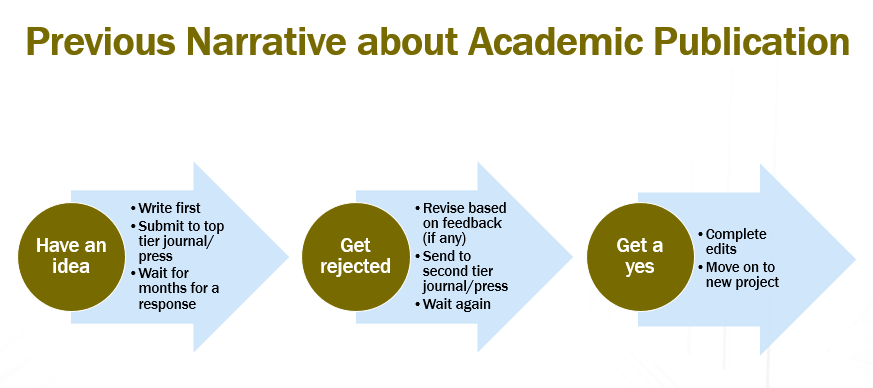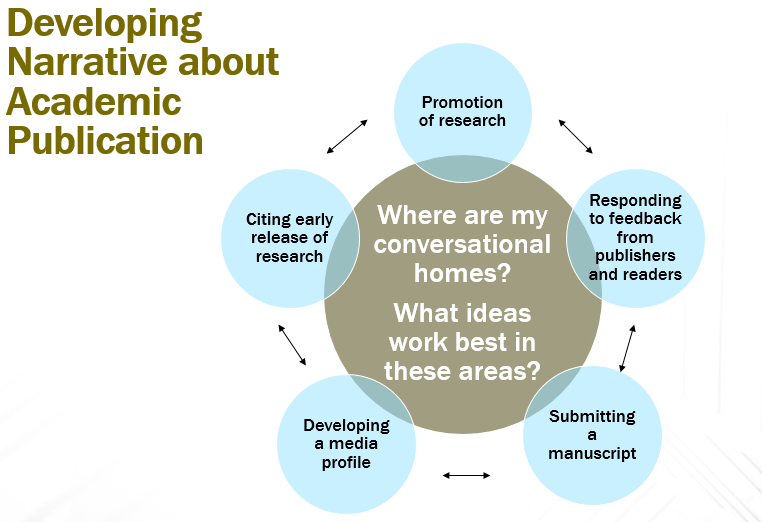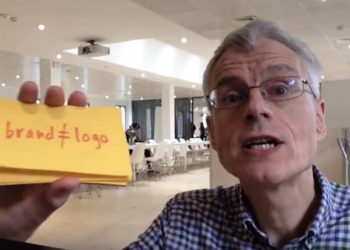Editor’s Note: the following is a guest post by Christine Tulley, based on a presentation at the 2019 Researcher to Reader Conference in London. Christine is Professor of English, Director of the Masters in Rhetoric and Writing Program, and Academic Development Coordinator at The University of Findlay, Ohio.
The academic publication lifecycle has undergone radical changes over the past several years. These changes have a significant impact on how scholarship will be written, published, promoted, and read in the future.
Previous narratives of how research moves from idea to publication generally emphasized a linear model that went something like this: the researcher 1) conducts a study or develops an idea 2) submits an article or a book to a top tier or aspirational journal/press and 3) if rejected, incorporates review feedback and sends it to the next publishing outlet down on the list until someone says yes.

Yet, emerging research on academics’ publishing habits over the past five years indicate that the process is now a series of loops and connections, with some actions repeated multiple times.
Trends in both scholarly publishing as well as libraries’ role in the research and publication processes confirm this shift from a linear process to a circular one. Research from both early career researchers across disciplines (CIBER 2016; Wells and Soderlund 2018) and experienced academics (Tulley 2018), in addition to a large scale study of academic publishing habits across the academic lifecycle conducted by Bec Evans and Chris Smith of Prolifiko, indicate the publishing process is no longer a linear process and the roles of libraries, publishers, and researchers have all developed in response to issues such as open access, REF guidelines in the UK and tenure and promotion processes in the US, and emerging support roles for academic libraries. As a researcher and faculty developer who specializes in moving authors from idea to publication, four significant shifts across disciplines have emerged in how ideas move from researchers to published research and back again to researchers as readers.
Shift 1: Academics Think Rhetorically (as Writers AND Readers)
Academics increasingly target a journal prior to writing and sometimes even before conducting research. Typically, journals are targeted because academics are already readers of those journals and interested in participating in the scholarly conversations happening in that space. In his interview in How Writing Faculty Write, Jonathan Alexander, Professor of English and Informatics at University of California-Irvine, claims, “I also want to push what we know collectively as readers…I don’t really publish in any journal that I don’t also consider myself a reader of, so I consider myself part of the readership of that journal. Knowing what I know about that readership, how can I try to advance a particular conversation or at least contribute to it?” In an age where new journals and sub-specialties emerge every day, particularly in the day and age of open access, academics can’t keep up with all of the new scholarship on their subject.
As a result, most tend to read a few select journals where they are interested in adding to and participating in the conversation about a specific line of research. Therefore, academics increasingly tend to think about writing for scholarly publication as not just a researcher/writer but simultaneously as a reader of a particular journal. Practically, this means that a researcher does not submit an article, get it published, and move on to a new project. Instead, academics work through multiple stages and multiple projects at one time, with some of these projects never officially ending.
Shift 2: After the Top 2-3 Journals, Rank Matters Less
Because researchers are thinking rhetorically, new research indicates they are more willing to take chances on newer journals, mid-tier journals, and open access journals that more directly address their particular interests. In workshops I give across different types of universities, scholars are particularly interested in mid-tier or newer journals that offer the option of early release, where accepted research is published immediately. This approach to publication from early career researchers, in particular, indicates that academics are adapting to the mixed publishing culture and after the top tier, choosing venues that better suit their publishing needs. This is promising, as open access requirements from Plan S and US organizations such as the Bill and Melinda Gates Foundation surely will affect how publicly funded scientific research is accessed. In the humanities, a willingness to publish in mid-tier venues also indicates that researchers might be more interested in the publisher of scholarship versus a singular journal in its roster. In 2016, Wiley offered the Wiley Humanities Festival, with access to 90 humanities journals. A linguistics scholar might choose to publish in any one of the 39 linguistically focused journals from Wiley (or similarly, any of the 27 from Elsevier), depending on the strand of research. If journal rank matters less after the top 2-3, the publisher might matter more, particularly in its approach to embargos, open access levels, and financial contributions from the authors toward publication.

Shift 3: Academics View Librarians as Scholarly Research “Partners” vs. Support
In the previous publication lifecycle model, academics might have called on librarians to help find a difficult to locate source or to order additional books for the stacks. Within the past few years, academics call on librarians as support partners for everything from locating early release research, to locating preprint servers for peer feedback prior to publication, to hosting workshops on publishing in open access journals. Libraries may even begin to host preprint servers, and thus become a hub of prepublication review, as in the case of Cornell University Libraries that currently hosts arXiv. As libraries begin to move away from expensive subscription models where a primary feature of the library is providing access to journal content (sometimes as much as a third of all university library expenditures in the US) , academics increasingly call on librarians to help with finding other types of scholarship. One key indicator is a survey that shows a 20% increase in academics starting research for a project with the library’s website vs. the website of a scholarly database such as JSTOR. If this trend continues, a university can tailor the library’s brand to suit the culture of researchers on that particular campus.
Shift 4: Academics Increasingly Work with Publishers to Promote Content
In the previous model of monograph publication, a researcher submitted a manuscript to a press and it was up to the press to promote the work for sales. The academic might have offered some marketing ideas or names of scholars to posit the work to, but the responsibility of selling the work landed with the publisher. Researchers across all career levels are now collaborating with publishers to promote the work. In my own case, after I published How Writing Faculty Write, with Utah State University Press, both the rhetoric and composition editor (Rachael Leavy) and I looked for ways to promote the work. If I gave a talk about the research, I would let her know so she could tweet it out that day. If she was exhibiting the book at a conference, she would put me in touch with buyers that day who wanted to talk more about the research. While many university presses have not developed guidelines for author promotion of content in a similar manner (or train authors informally, as in my case), many subscription-based journals increasingly offer instruction to academics in effective promotion strategies. SAGE, for example, offers guidelines for social media usage such as tweeting. Elsevier offers authors tips on search engine optimization and conference promotion skills. And in the age of preprint publishing, authors can spread the word about research prior to a peer reviewed publication.
These trends have led to a shaping a developing model of academic publishing, where stages are returned to multiple times and out of any particular order.

Looking at this new model, one author might start promoting research as soon as study findings are analyzed as a way to gain interest for a forthcoming article (still in the process of being written). Another author, after receiving a revise-and-resubmit response from a scholarly journal, might crowdsource findings to find a way to address reviewer feedback more effectively. A third author might submit a manuscript, but not to a journal. Instead, an author might choose to submit an article draft for feedback to one of the preprint servers such as arXiv, ChemRxiv, and bioRxiv as a means of getting peer feedback prior to an official submission to a scholarly journal that permits preprint submission (and many journals in the sciences do). New postgraduate students are now regularly trained at many institutions on developing media profiles as they search for academic positions.
Based on these four shifts, there are two key directions where the scholarly publishing community can work to attract authors, readers, and scholarly partners such as libraries.
First, both scholarly publishers and libraries, as well as universities, can offer training to academics in how to promote their published content. Both Sage and Wiley offer such author guidelines. As subscription-based journals face threats such as Plan S to their financial models, developing these types of content and workshops offer an incentive to authors to publish with these venues. Moreover, in times of cost cutting at university presses, the increase in this type of guidance from publishers suggests a trend, and an expectation, that academic authors have a role to play in promoting their own research instead of relying on publishers to do all of the promotional work.
Libraries such as Georgetown University and Binghamton University in New York also offer workshops to academics in how to promote published scholarship. The University of York offers resources for academics in doing media contact and Queen’s University in Canada offers a helpful list for academics to determine when their research becomes “news” and worthy of promotion. These types of examples indicate that universities are seeking to maximize academic reputation. Offering to help academics publicize their research is a way to do this type of promotion cost effectively and spread the workload.
Second, because rank matters less after the top tier for many academics, newer journals and open access journals can attract new writers and readers. This trend also suggests that some academics might be willing to look at digital-only journals or multimedia journals as a publishing outlet. The offer of early release of accepted research is particularly attractive for US-based faculty on a tenure track who must publish as much as possible within the first 5-7 years of hire. For larger scholarly publishing venues, an openness on the part of researchers to a variety of types of publishing offers opportunities for publishers to add journals that do not currently exist on the roster or to explore more cost-efficient models of publishing.
Ultimately, all affected parties (researcher, reader, library, university, scholarly publisher, individual journal editors and reviewers) have altered roles to play in the emerging lifecycle of academic publishing. As a researcher who writes for publication, but also someone who supports academics who write, I’d like to see publishers recognize the fluid publication lifecycle at the point of submission. Submission spaces have, more or less, retained the traditional model of inviting an author to submit a manuscript, and waiting for a review to return. Few guidelines exist for published authors promoting research prior to publication beyond rules about previous publication. I’d also like to see academic libraries thinking about offering collections in terms beyond published scholarship including data sets, author commentary on projects, and public peer review of work in progress.
Discussion
2 Thoughts on "Guest Post — Emerging Trends in the Academic Publishing Lifecycle"
Thanks for this very interesting post! I’d be interested to hear more about this perception of librarians as partners versus support. I’m not sure I fully understand the shift that is being observed here, particularly given the use of the phrase “support partners.”



